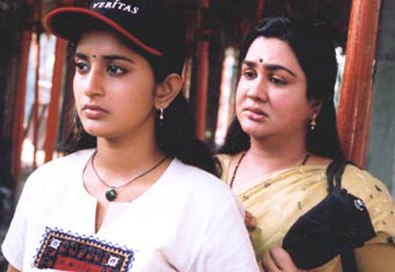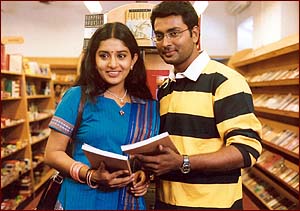Getting to know artistic filmmakers of India!
By K.S.SIVAKUMARAN
 The
purpose of this week's column is to update the names of some of the Indian
filmmakers who have created some artistic films in different languages
in that country, for the benefit of interested readers. Most readers are
familiar with the films made in Hindi and Thamil languages as they are
shown in Colombo and outstations, but there are good films made in other
languages as well. Bengali, Malayalam, Marati, Kannada, Telugu, Oriya,
Punjabi, Assamese. Manipuri are some of these languages in which some outstanding
films had been made.
The
purpose of this week's column is to update the names of some of the Indian
filmmakers who have created some artistic films in different languages
in that country, for the benefit of interested readers. Most readers are
familiar with the films made in Hindi and Thamil languages as they are
shown in Colombo and outstations, but there are good films made in other
languages as well. Bengali, Malayalam, Marati, Kannada, Telugu, Oriya,
Punjabi, Assamese. Manipuri are some of these languages in which some outstanding
films had been made.
I saw some of these films
in December last year in the capital city (Panaji) of the state of Goa.
These films were both feature and non-feature
presentations.
The dividing line between artistic films and commercial films has now become obscure because some films that are commercially successful are also well made as artistic creations. At the same time, most films produced in Bollywood (those produced in Mumbai, especially in Hindi) and Kodambakkam (those produced in Chennai, especially in Thamil and Telugu) do not cater to the finer tastes of an intelligent viewer. But they satisfy the dreams of the not so educated masses of India. Plausibility is willingly suspended by the viewer. Most such films rekindle emotions in an irrational way to suit the orthodox customs of human behaviour in rural India.
Cinema as a 'dream factory'

The producers of most films
are big financiers with lumpen attitudes and they come from the rural and
uneducated segments of the society. The
bottomline as far as the
main ingredients are concerned is 'entertainment' (meaning fantasy, violence
and crude forms of sexuality). Such 'Masala' (a cocktail of several threads
of unwholesome and blatantly idiotic sequences) films are box office hits
in the Indian subcontinent... The storyline of most films does have a strong
plot and themes, but it is not directed with a sense of purpose or focus.
Lots of irrelevancies creep in. The accent is on 'glamour' (meaning seductive
dances, jive and of course haunting music now generated as 'fusion' music.
The directors and 'stars'
(as opposed to 'actors' or 'players') are also invariably not trained to
suit the medium of 'cinema' which is essentially a
visual of 'moving images'
with sparse dialogues, silences and deeper unfolding of human relationships
(and which is not, understandably, a fast
development and has its own
slow space that awakens the sensitive viewer and give him or her a 'cathartic'
impact). Even today some unpalatable Indian films (it could be in any Indian
language) remain 'photographed dramas' with long speeches and almost never
ending conversations.
Amidst this background had emerged some outstanding film directors and players with a grounding of understanding the language of the medium. They are trained. Intellectuals (by this, I mean those knowledgeable people with an analytical mind) among them have produced some outstanding 'artistic' films. This includes both men and women. This is not a place for me to recount the contributions and name the contributors of the Indian cinema in totality. But I shall mention a few of them among those who presented their films at the IFFI (International Film Festival of India) 2005 in the capital (Panaji) of Goa in north-western part of India. Hitherto this prestigious International Film Festival was held in the mega-capitals of a few Indian states. But from 2005 it is going to be in one venue -Goa.
The Image Makers
 A
remarkable feature in contemporary Indian cinema is the clever use of technology,
colour and tight editing and fast movement. This is particularly so in
Thamil and Hindi films. Some of the outstanding film directors and players
and technicians and cinematographers had had their training at the FTTI
(Film and Television Training Institute of India) in Pune in the Maharashtra
state whose capital is Mumbai. And some of them had been trained at the
film institute in Chennai, as well. The use of digital cameras, computing,
imaginative graphic designs and fantastic mixing of fusion music of classics
as well as 'pops' of both the east and west and seductive dances of the
west have given the ' zing ' audience of youth a viable medium of expression.
Taboo subjects are now handled with discretion and dexterity. The duration
of the films have now been reduced from three hours to less then two hours,
which is good.
A
remarkable feature in contemporary Indian cinema is the clever use of technology,
colour and tight editing and fast movement. This is particularly so in
Thamil and Hindi films. Some of the outstanding film directors and players
and technicians and cinematographers had had their training at the FTTI
(Film and Television Training Institute of India) in Pune in the Maharashtra
state whose capital is Mumbai. And some of them had been trained at the
film institute in Chennai, as well. The use of digital cameras, computing,
imaginative graphic designs and fantastic mixing of fusion music of classics
as well as 'pops' of both the east and west and seductive dances of the
west have given the ' zing ' audience of youth a viable medium of expression.
Taboo subjects are now handled with discretion and dexterity. The duration
of the films have now been reduced from three hours to less then two hours,
which is good.
I had the opportunity of watching some of the recent films made in India in various languages. They are both feature and non-feature films. The films shown at the IFFI- Goa were in Hindi, Bengali, Malayalam, Kannada, Telugu, Assamese, Marati, English and Thamil.
Kerala, which in the south west of India, produces some outstanding films in the Malayalam language. These are the new directors that have come to be noticed:
Sathyam Anthikkad, Jayaraj, Albert, T.V. Chandran, Blessy Ipe Thomas, Pradeep Nair, Kamal, V.R.Gopinath, and Adoor Gopalakrishnan (a maestro). The films they made and showed were: Achuvinte Amma, Daivanamathil, Kannae Madanguka, Kathavasheshan, Kazcha, Oridam, Perumazakkalam, Kamal, Chitrasmruthi, and Kalamandalam Raman Kuty Nair.
West Bengal produces outstanding films in the Bangla (Bengali) language. Here is a list of some of the directors and their films:
Rituparno Gosh (Antarmahal), Abhijit Dasgupta (Ditiyo Bashanta) Buddhadeb Dasgupta (Kaalpurush and Swapner Din), Sekhar Das (Krantikkal).
 Other
directors include P.Sheshadri who made a film in Kannada language ( Beru),
Mohan Krishna Indraganti who made a film in Telugu language (Grahanam),
Girish Kasaravalli ( a maestro) who made a film in Kannada language ( Hasina),
Nagesh Kukunoor who made a film in Hindi (Iqbal), Manju Borah who made
a film in Assamese language ( Laaz),Madhur Bandarkar who made a film in
Hindi (Page 3), Amol Palekar (a maestro) who made a film in Hindi ( Paheli),
Ameer who made a film in Thamil (Raam), and Bipin Nadkarni, who made a
film in Marati language (Uttarayan).
Other
directors include P.Sheshadri who made a film in Kannada language ( Beru),
Mohan Krishna Indraganti who made a film in Telugu language (Grahanam),
Girish Kasaravalli ( a maestro) who made a film in Kannada language ( Hasina),
Nagesh Kukunoor who made a film in Hindi (Iqbal), Manju Borah who made
a film in Assamese language ( Laaz),Madhur Bandarkar who made a film in
Hindi (Page 3), Amol Palekar (a maestro) who made a film in Hindi ( Paheli),
Ameer who made a film in Thamil (Raam), and Bipin Nadkarni, who made a
film in Marati language (Uttarayan).
Among those who made non-feature films were:
Altaf Majid (Assameese), V.R.Gopinath (English / Malayalam), Anirban Datta (Bengali / Hindi), Laksmikant Shetgaonkar (Marati), Umesh Vinayak Kulkarni (Marati), Sutaapa Deb (English), Gautam Saikia (English)K. Bikram Singh (English), Joshy Joseph (English), Papia Roy (English), Arun Khopkar (English) Shilpi Dasgupta (Hindi), Bappa Ray ( English), S.M.Vasanth (Thamil) and Pankaj Bhutalia (English)
Contact: sivakumaranks@yahoo.com





